Weather: Russia (including European Russia), Armenia, Azerbaijan, Georgia
Although its reputation precedes it, Russia's climate is extreme only after a particular fashion. There's no sugar-coating the fact that Russian winters are extremely cold. Yet much of the country enjoys warm mid-summer days that average above 20°C/68°F, and there are even a few bona fide hot spells. Thunderstorms are seldom intense outside of the […]
How winter came to Russia’s aid
Like a judo expert manipulating another's strength to his advantage, Russia learned through years of experience how to use the power of wintertime in its own defence. Would-be conquerors who extended their stay past the autumn equinox did so at their own risk, as Napoleon discovered in 1812. That September, some 400,000 of his troops […]

The Soviet Union’s Nuclear Legacy
As you have read, the breakup of the Soviet Union sparked regional conflicts and economic hardship. Equally serious were the problems caused by the Soviet Union's nuclear programs. These included nuclear warheads atop ballistic missiles, poorly constructed and maintained nuclear power stations, and decaying nuclear waste dumps. All threatened the region's people and environment. An […]
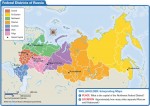
Russia and the Republics: The Struggle for Economic Reform
A HUMAN PERSPECTIVE Russians have faced many hardships since the breakup of the Soviet Union. But few have been as difficult to overcome as the collapse of the Soviet command economy. After the Soviet Union collapsed in 1991, the region's people began to participate in a capitalist system. One Russian bitterly summed up the sudden […]
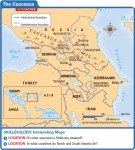
Russia and the Republics: Regional Conflict
A HUMAN PERSPECTIVE The powerful central government of the Soviet Union once maintained tight control over Russia and the Republics. But when the Soviet Union collapsed in 1991, central authority weakened. Crime, conflict, and other signs of instability increased. As one former Soviet citizen put it,“We're floating in a zone of half-lawlessness, half-law. . . […]

Russia and the Republics: Central Asia
A HUMAN PERSPECTIVE Central Asia has inspired the dreams of many adventurers—and presented them with many dangers. In the 19th century, agents of the mighty British Empire found that even they were not safe there. In 1842, two British officers were captured in the Central Asian city of Bukhoro. For months, the city's ruler kept […]
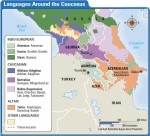
Russia and the Republics: Transcaucasia
A HUMAN PERSPECTIVE Throughout history, human beings have migrated through Transcaucasia, which today consists of the republics of Armenia, Azerbaijan, and Georgia. Recent discoveries have shown just how early such migrations began. In the summer of 1999, a team of scientists discovered two 1.7-million-year-old human skulls in the Transcaucasian republic of Georgia. They were the […]

Russia and the Western Republics
A HUMAN PERSPECTIVE Early in the 1500s, the Russian leader Ivan the Great put an end to two centuries of foreign rule in his homeland. Russia then entered a period of explosive growth. From its center in Moscow, Russia expanded at a rate of about 55 square miles a day for the next four centuries. […]

Russia and the Republics: Human-Environment Interaction
A HUMAN PERSPECTIVE Since the 1960s, irrigation policies in Central Asia have had a dramatic impact on the Aral Sea. A recent visitor to an old Aral fishing village described the change: “I stood on what had once been a seaside bluff . . . but I could see no water. The sea was twenty-five […]

Russia and the Republics: Climate and Vegetation
A HUMAN PERSPECTIVE Large areas of Russia and the Republics are extremely cold during much of the year. For example, the Siberian town of Oymyakon has reportedly had temperatures as low as –95°F. At such temperatures, the cold can crack steel and cause tires to explode. When you exhale, your breath freezes into crystals that […]
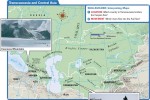
Russia and the Republics: Landforms and Resources
A HUMAN PERSPECTIVE Russia and the Republics occupy a tremendous expanse of territory—approximately three times the land area of the United States. The region sprawls across the continents of both Europe and Asia and crosses 11 time zones. When laborers in the western city of Kaliningrad are leaving their jobs after a day's work, herders […]

Yenisey-Angara River
THE YENISEY AND ANGARA rivers form a dividing line between western and eastern SIBERIA. Like the other major rivers of the region, they flow from highlands in the south across the flat north Siberian plains to the ARCTIC OCEAN. The watershed also includes the subbasin of Lake BAIKAL, the second-largest body of fresh water in the world. Most of the Yenisey-Angara basin […]
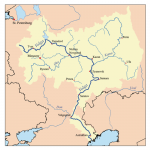
Volga River
THE VOLGA RIVER is considered to be the mother of Russian rivers. Europe's longest, it drains an area of 550,288 square mi (1,410,994 square km), roughly 40 percent of European RUSSIA. From its origins in the heavily forested hills near the Baltic Sea to its mouth on the CASPIAN SEA 2,300 mi (3,700 km) away, the river passes through much of […]

Ural Mountains
THE URALS EXTEND over 1,553 mi (2,500 km) from the ARCTIC OCEAN to the steppes of KAZAKHSTAN. The territory of nearly 318,148 square mi (824,000 square km) is subdivided in the oblasti (districts) of Perm, Cheliabinsk, Kurgansk, Orenburg, and the Autonomous Republics of Udmurtia and Bashkiria. The Ural highlands, with the highest peak of Narodnaya (6,213 ft or 1,894 m), separate the […]

Siberia
SIBERIA, INCLUDING the Russian Far East, covers 4.9 million square mi (12.8 million square km), an area that is three-fourths of the Russian Federation or onethird larger than the UNITED STATES and one-fourth larger than CANADA. Siberia stretches from the URALS in the west over 3,000 mi (5,000 km) to the PACIFIC OCEAN in the east. It has borders with KAZAKHSTAN, MONGOLIA, […]
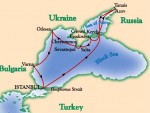
Sea of Azov
THE SEA OF AZOV is an arm of the BLACK SEA, extending from the mouth of the River Don to the Kerch Strait. It covers 14,520 square mi (37,230 square km) and is 226 mi (365 km) east to west, and 110 mi (175 km) north to south. RUSSIA borders the sea to the east, with UKRAINE to the north […]
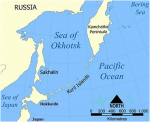
Sakhalin Island
SAKHALIN IS THE LARGEST island of the Russian Federation, 589 mi (948 km) long and 16 to 105 mi (25 to 170 km) wide, with an area of 24,560 square mi (78,000 square km). Sakhalin is separated from the mainland by the narrow and shallow Mamiya Strait or Strait of Tartary, which often freezes in winter in its narrower part, and […]
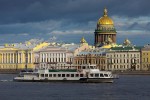
Saint Petersburg
THE CITY OF SAINT Petersburg in RUSSIA is known throughout the world as one of the marvels of urban planning and magnificent architecture. As the capital of the Russian Empire from 1712 to 1918, the city was the staging ground for the dramatic events of Russian history, from Peter the Great's forced introduction of Western (modern) customs in the early 18th […]

Russian Federation
Area 6.6 million square mi (17 million square km) Population 143.8 million 2014 Capital Moscow Highest Point 18,476 ft (5,633 m) Lowest Point -91 ft (-28 m) GDP $1.861 trillion 2014 Primary Natural Resources oil, natural gas, coal. STRETCHING IN A GIGANTIC arc around the ARCTIC OCEAN and North Pole, the Russian Federation spans 11 time zones, nearly half the globe from east […]

Ob-Irtysh River
THE OB AND THE IRTYSH rivers together form one of the largest river BASINs in the world, but also drain an area among the least populated and least known to outsiders. The rivers flow from the isolated mountain ranges of Central Asia (the ALTAI and Sayan ranges) across the sparsely populated Western Siberian Lowland to […]
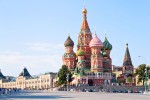
Moscow
MOSCOW IS THE capital city of the Russian Federation, and although superseded as the official capital during the 18th and 19th centuries, it has dominated Russian politics, culture, and economics since the 14th century. Today, it is RUSSIA's largest city and one of the largest urban centers in Europe. Geographically, Moscow lies at the center […]
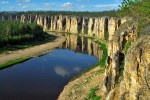
Lena River
THE LENA RIVER is one of Russia's great northern rivers, draining an area of 899,641 square mi (2,306,772 square km) and encompassing a region rich in wildlife and natural resources, including one of the world's largest deposits of gold. This is also one of the most inhospitable regions on the planet, with extremes of temperature […]
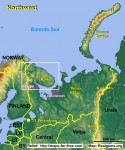
Kola Peninsula
THE KOLA PENINSULA IS one of RUSSIA's regions of great contrast: at once an area of stark natural beauty and of severe ecological danger; rich in minerals, but one of Russia's poorest regions; and an area that is both closely linked to the concerns of Western Europe and strictly isolated from the outside world. The […]

Kamchatka Peninsula
RUSSIA'S FAR EAST IS MARKED by the large mountainous peninsula known as Kamchatka. Kamchatka peaks form one of the most volcanically active regions on earth, counting over thirty active cones, and at least a hundred more that are now inactive. Few people live in this remote corner of Asiatic Russia, where ties to central government, […]

Junngar Basin
THE JUNNGAR BASIN (also Dzungar) is one of the two major basins that make up much of northwestern CHINA's XINJIANG province (Xinjiang Uygur Autonomous Region). The basin, covering some 69,500 square mi (180,000 square km), is located to the north of the TIAN SHAN MOUNTAINS and has a mixed landscape that includes mountains, deserts, steppes, […]

Elbrus, Mount
MOUNT ELBRUS IS the highest point in Europe, at 18,513 ft (5,642 m). It is the central peak of the CAUCASUS MOUNTAINS range, located 6.8 mi (11 km) north of the main ridge that forms the boundary between GEORGIA and RUSSIA, thus placing the mountain within Europe, since the traditional dividing line between Asia and […]
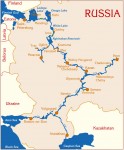
Don River
THE DON RIVER IS one of RUSSIA's major commercial rivers, which, connected to the VOLGA through the 65-mi (105-km) Volga-Don Canal, allows river traffic to sail from Russia's interior ports as far inland as MOSCOW to ports on the BLACK SEA and beyond to the MEDITERRANEAN. The Don River basin also includes its most important […]
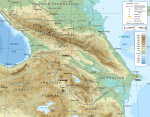
Caucasus Mountains
THE CAUCASUS MOUNTAINS are the highest mountain range in Europe, but lie at the very eastern extremity of what geographers consider to be Europe. In fact, the dividing line traditionally used to divide Europe from Asia runs directly through the center of the range. Forming both a barrier and a connector for civilizations between the […]
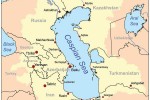
Caspian Sea
THE CASPIAN SEA IS ONE of the world's largest bodies of water, situated in a depression between RUSSIA, KAZAKHSTAN, TURKMENISTAN, IRAN, and AZERBAIJAN. It is unique among the world's inland seas in that it is completely isolated from the rest of the global ocean and has a distinctive continental climate which gives the area extremes […]

Black Sea
THE BLACK SEA IS a body of salt water that stretches 630 mi (1,014 km) from east to west. TURKEY faces its southern shore, BULGARIA and ROMANIA lie west of the Black Sea, and UKRAINE, RUSSIA, and GEORGIA border it to the north, northeast, and east, respectively. The Black Sea stretches 330 mi (530 km) […]
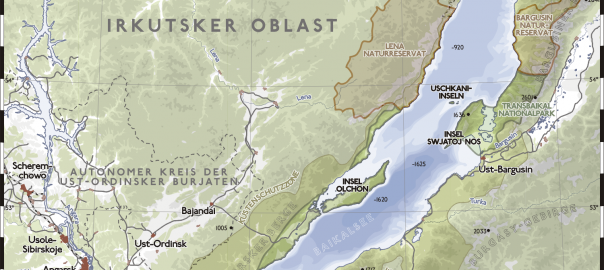
Baikal, Lake
THE BAIKAL, the world's deepest lake, stretches 391 mi (636 km) long and nearly 50 mi (80 km) wide. On the northeastern borders of central Asia, it lies at an altitude of 1,494 ft (455.6 m) above the PACIFIC OCEAN sea level. With an area of 12,162 square mi (31,500 square km), the Baikal ranks […]

Amur River
THE AMUR RIVER, in Siberia, springs from the confluence of the Shilka and Argun Rivers east of Lake BAIKAL and flows over 1,800 mi (2,897 km) toward the Tatar Straits, the passage between Sakhalin and the Russian Pacific Coast. With all tributaries, the Amur basin covers nearly 750,000 square mi (1,942,491 square km) of area. […]
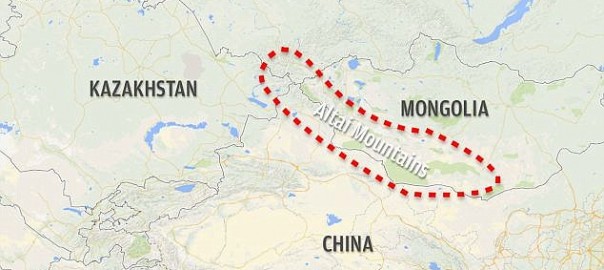
Altai Mountains
THE ALTAI MOUNTAINS are a system of remote mountains in central Asia that cover an area of 326,256 square mi (845,000 square km) bounding RUSSIA, KAZAKHSTAN, MONGOLIA, and CHINA. This system is a natural marvel that has been largely untouched by large industries and has a very sparse population. Its name is derived from the […]